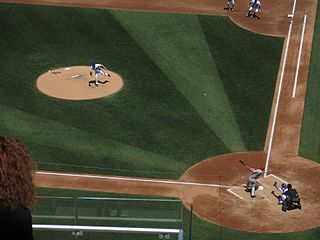
Baseball is a bat-and-ball sport played between two teams of nine players each, taking turns batting and fielding. The game occurs over the course of several plays, with each play generally beginning when a player on the fielding team, called the pitcher, throws a ball that a player on the batting team, called the batter, tries to hit with a bat. The objective of the offensive team is to hit the ball into the field of play, away from the other team's players, allowing its players to run the bases, having them advance counter-clockwise around four bases to score what are called "runs". The objective of the defensive team is to prevent batters from becoming runners, and to prevent runners' advance around the bases. A run is scored when a runner legally advances around the bases in order and touches home plate.
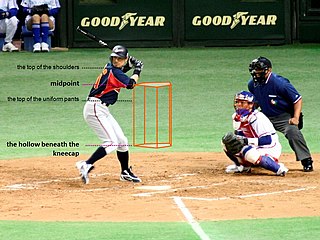
In baseball, the strike zone is the volume of space through which a pitch must pass in order to be called a strike even if the batter does not swing. The strike zone is defined as the volume of space above home plate and between the batter's knees and the midpoint of their torso. Whether a pitch passes through the zone is decided by an umpire, who is generally positioned behind the catcher.

Alexander Joy Cartwright Jr. was a founding member of the New York Knickerbockers Base Ball Club in the 1840s. Although he was an inductee of the Baseball Hall of Fame and he was sometimes referred to as a "father of baseball", the importance of his role in the development of the game has been disputed.
1845 in sports describes the year's events in world sport.
The question of the origins of baseball has been the subject of debate and controversy for more than a century. Baseball and the other modern bat, ball, and running games – stoolball, cricket and rounders – were developed from folk games in early Britain, Ireland, and Continental Europe. Early forms of baseball had a number of names, including "base ball", "goal ball", "round ball", "fetch-catch", "stool ball", and, simply, "base". In at least one version of the game, teams pitched to themselves, runners went around the bases in the opposite direction of today's game, much like in the Nordic brännboll, and players could be put out by being hit with the ball. Just as now, in some versions a batter was called out after three strikes.
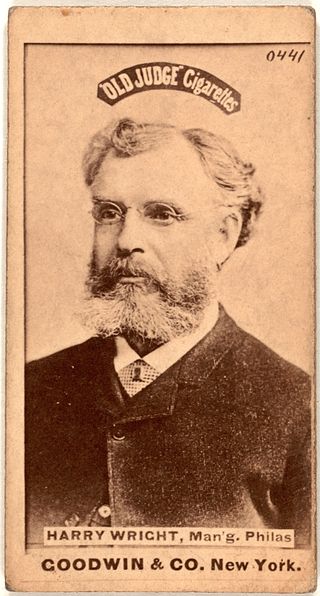
William Henry "Harry" Wright was an American professional baseball player, manager, and developer. He assembled, managed, and played center field for baseball's first fully professional team, the 1869 Cincinnati Red Stockings. He is credited with introducing innovations such as backing up infield plays from the outfield and shifting defensive alignments based on hitters' tendencies. For his contributions as a manager and developer of the game, he was inducted into the Baseball Hall of Fame in 1953 by the Veterans Committee.
Town ball, townball, or Philadelphia town ball, is a bat-and-ball, safe haven game played in North America in the 18th and 19th centuries, which was similar to rounders and was a precursor to modern baseball. In some areas, including Philadelphia and along the Ohio River and Mississippi River—the local game was called Town Ball. In other regions the local game was named "base", "round ball", "base ball", or just "ball"; after the development of the "New York game" in the 1840s it was sometimes distinguished as the "New England game" or "Massachusetts baseball". The players might be schoolboys in a pasture with improvised balls and bats, or young men in organized clubs. As baseball became dominant, town ball became a casual term to describe old fashioned or rural games similar to baseball.

Throughout the history of baseball, the rules have frequently changed as the game continues to evolve. A few common rules most professional leagues have in common is that four balls is a base on balls, three strikes is a strikeout, and three outs end a half-inning.
The Knickerbocker Rules are a set of baseball rules formalized by William R. Wheaton and William H. Tucker of the Knickerbocker Base Ball Club in 1845. They have previously been considered to be the basis for the rules of the modern game, although this is disputed. The rules are informally known as the "New York style" of baseball, as opposed to other variants such as the "Massachusetts Game" and "Philadelphia town ball".
The National Association of Base Ball Players (NABBP) was the first organization governing American baseball.

The Elysian Fields in Hoboken, New Jersey, was recreational parkland located on the city's northern riverfront in the 19th century. The area was a popular getaway destination for New Yorkers in the 19th century, much in the tradition of the pleasure garden, offering open space for a variety of sports, public spectacles, and amusements. The lavish grounds hosted the Colonnade Hotel and tavern, and offered picnic areas, a spa known as Sybil's Cave, river walks, nature paths, fishing, a miniature railroad, rides and races, and a ferry landing, which also served as a launch for boating competitions.
The following are the baseball events of the years 1845 to 1868 throughout the world.
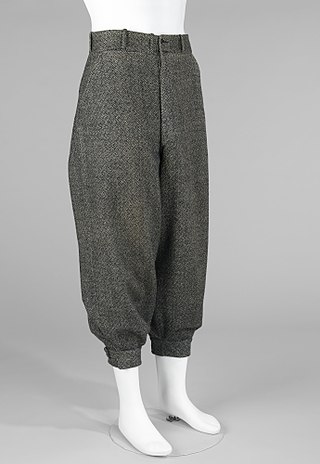
Knickerbockers,or knickers in the United States (US), are a form of baggy-kneed breeches, particularly popular in the early 20th-century United States. Golfers' plus twos and plus fours are similar. Until after World War I, in many English-speaking countries, boys customarily wore short pants in summer and "knee pants" similar to knickers in winter. At the onset of puberty or sometime in their teens, they graduated to long trousers. In that era, the transition to "long pants" was a major rite of passage. Men continued to wear knickerbockers for athletics, outdoor work, and other informal activities for which they were practical. During the early 20th century, knickerbockers were also increasingly worn by women.
The Massachusetts Game was a type of amateur club baseball popular in 19th century New England. It was an organized and codified version of local games called "base" or "round ball", and related to Philadelphia town ball and rounders. The Massachusetts Game is remembered as a rival of the New York Game of baseball, which was based on Knickerbocker Rules. In the end, however, it was the New York style of play which was adopted as the "National Game" and was the fore-runner of modern baseball.
The Enterprise Base Ball Club of Brooklyn was an American baseball club in the 1850s and 1860s.

Daniel Lucius "Doc" Adams was an American baseball player and executive who is regarded by historians as an important figure in the sport's early years. For most of his career he was a member of the New York Knickerbockers. He first played for the New York Base Ball Club in 1840 and started his Knickerbockers career five years later, continuing to play for the club into his forties and to take part in inter-squad practice games and matches against opposing teams. Researchers have called Adams the creator of the shortstop position, which he used to field short throws from outfielders. In addition to his playing career, Adams manufactured baseballs and oversaw bat production; he also occasionally acted as an umpire.
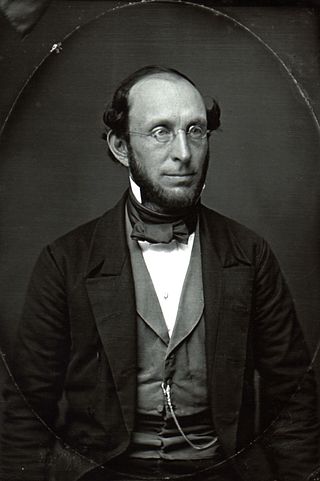
William Rufus Wheaton was an American lawyer and politician. He was also a baseball pioneer.

Duncan Fraser Curry was an American baseball pioneer and insurance executive.
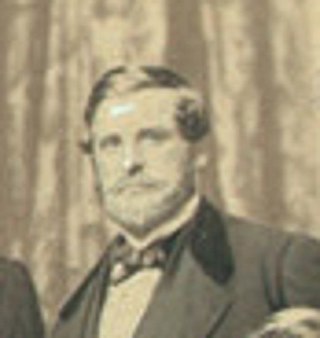
William H. Tucker was an American baseball pioneer, who was a player and organizer with the New York Knickerbockers in the 1840s.
The 1857 baseball convention was a meeting of members from 16 New York City-area baseball clubs that took place over multiple sessions in early 1857. It passed numerous clarifications of the pre-existing Knickerbocker Rules and modifications that helped lead to the modern format of baseball games. Among the items formalized were the length of games and the distance between bases.













